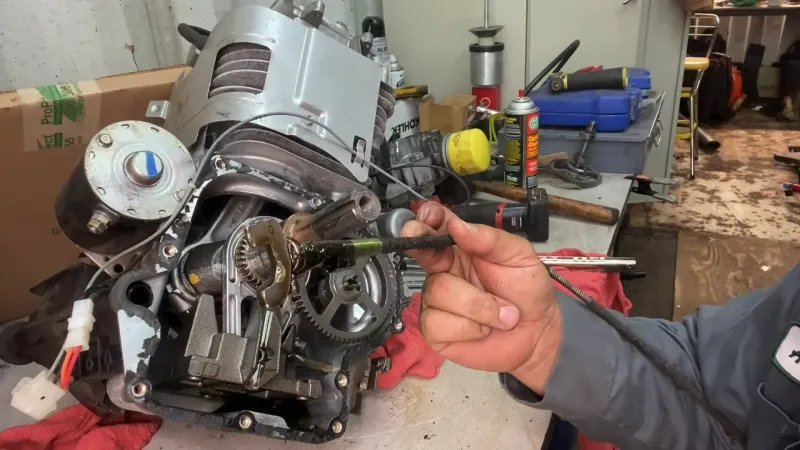Why My Briggs and Stratton Compression Release Stuck?

The compression release on a Briggs & Stratton engine is a small valve. It allows the engine to turn over more easily when starting. It works by releasing some of the compression in the cylinder when the starter is engaged. This reduces the amount of resistance the engine has to overcome.
However, it is not uncommon for the compression release to become stuck. This can make starting the engine difficult or impossible. If you are experiencing this problem with your Briggs & Stratton engine, there are a few potential causes and solutions that you can try.
You'll Learn About
Briggs and Stratton Compression Release Stuck
You may have a problem with your starter or starter circuit. You can check the starter by removing the spark plug and turning the engine over by hand. If it turns over smoothly and easily, then the starter is not the problem.
If it is difficult to turn over, then the starter may be the problem. You can also check the starter circuit by using a multimeter. Test the voltage at the starter when you try to start the engine. If the voltage is low, then you may have a problem with the battery, the connections, or the starter solenoid.
If the voltage is normal, then the problem may be with the starter itself.
Symptoms of a Stuck Compression Release

Difficulty Starting the Engine
If the compression release on your Briggs & Stratton engine is stuck, you may experience difficulty starting the engine. The engine may turn over but not start. These are the most common symptoms of a stuck compression release.
Slow Cranking Speed
Other symptoms may include a slow cranking speed when starting the engine. The engine may start but then stall soon after. If you notice any of these symptoms, it is important to address the problem as soon as possible. This will prevent further damage to the engine.
Causes of a Stuck Compression Release
There are a few different causes that can contribute to a stuck compression release on a Briggs & Stratton engine.
Worn or Broken Compression Release
One of the most common causes is a worn or broken compression release. The compression release is a small valve that is subjected to a lot of wear and tear. Over time, it can become worn or broken. This can cause it to become stuck.
Improper Valve Adjustment
Another possible cause is improper valve adjustment. If the valves are not adjusted properly, it can cause the engine to have difficulty starting or running properly. Finally, fluid in the cylinder can also cause the compression release to become stuck.
This can be caused by a leaking head gasket. It can also be caused by using the wrong type of oil or fuel. If you suspect that fluid in the cylinder is causing the problem, it is important to address the issue as soon as possible. This will prevent further damage to the engine.
How to Fix a Stuck Compression Release?

If you are experiencing a stuck compression release on your Briggs & Stratton engine, there are a few steps you can take to try to fix the problem.
The first step is to adjust the valves. If the valves are not adjusted properly, it can cause the engine to have difficulty starting or running properly.
To adjust the valves, you will need to locate the valve adjustment screws on the engine. Adjust them to the proper clearance according to the manufacturer’s specifications. If adjusting the valves does not fix the problem, you may need to replace the compression release.
This will require disassembling the engine to access the compression release. It may be a more involved repair. Finally, you should also check for fluid in the cylinder. If fluid is present, it could be causing the compression release to become stuck.
To check for fluid, remove the spark plug and inspect the cylinder for any signs of fluid. If you find fluid, you will need to determine the source of the leak and fix it before attempting to start the engine again.
Preventing a Stuck Compression Release
There are a few steps you can take to prevent the compression release on your Briggs & Stratton engine from becoming stuck. One of the most important steps is to perform regular maintenance and adjustment of the valves.
Proper Valve Adjustment
Proper valve adjustment is essential for the proper functioning of the engine. If the valves are not adjusted properly, it can lead to problems like a stuck compression release. You should also be sure to use the proper fuel and oil for your engine.
Use Proper Fuel
Using the wrong fuel or oil can cause problems with the engine. This includes a stuck compression release. Finally, it is important to store the engine properly during the off-season. This will help prevent problems like a stuck compression release.
This may include covering the engine, using a storage shed or garage, and taking other steps to protect the engine from the elements. By following these simple steps, you can help prevent a stuck compression release and keep your engine running smoothly.
Conclusion
A stuck compression release on a Briggs & Stratton engine can be a frustrating and potentially serious problem. It is important to address this issue as soon as possible to prevent further damage to the engine.
If you are experiencing a stuck compression release, there are a few steps you can take to try to fix the problem. These include adjusting the valves, replacing the compression release, or checking for fluid in the cylinder.
To prevent a stuck compression release in the future, it is important to perform regular maintenance and valve adjustment. You should also use the proper fuel and oil and store the engine properly during the off-season.
By following these simple steps, you can help ensure that your Briggs & Stratton engine continues to run smoothly and reliably.
